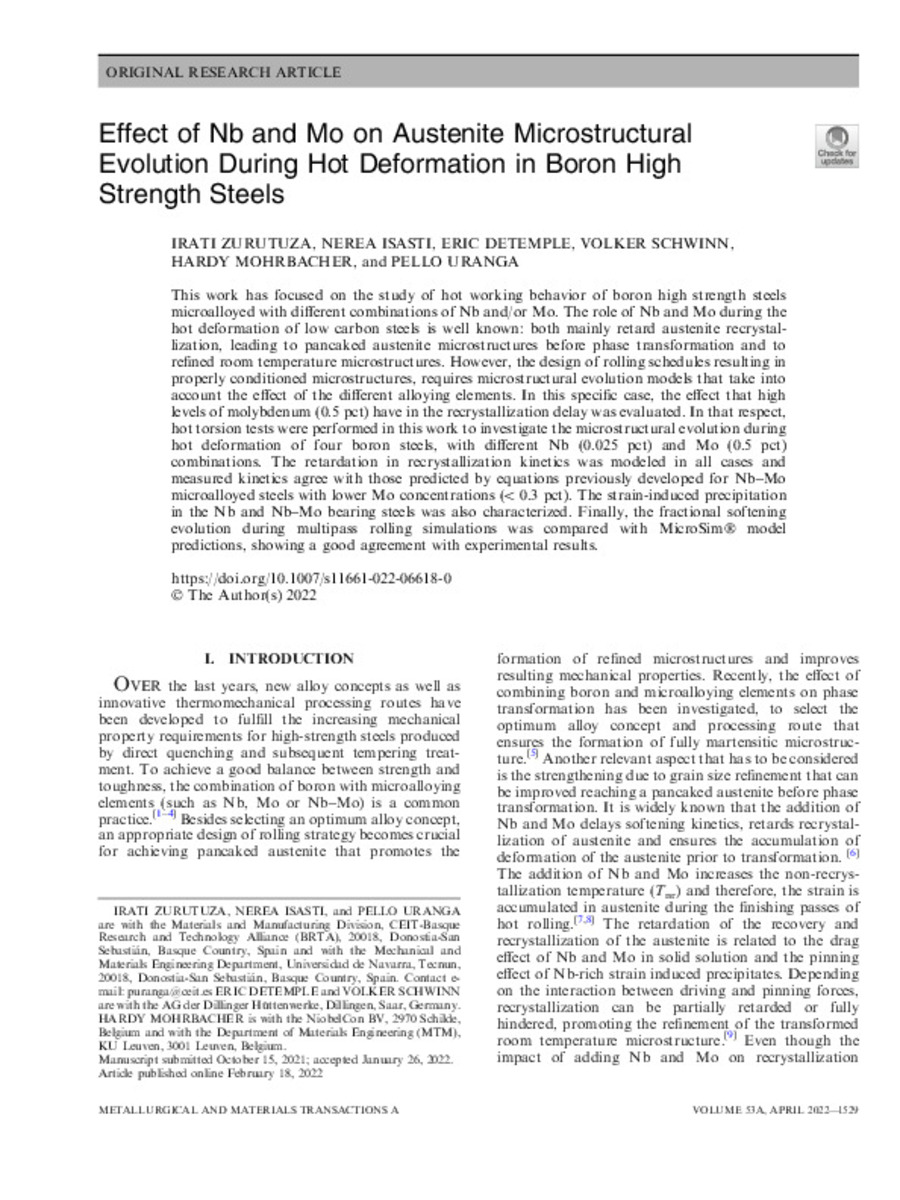Full metadata record
| DC Field | Value | Language |
|---|---|---|
| dc.creator | Zurutuza, I. (Irati) | - |
| dc.creator | Isasti-Gordobil, N. (Nerea) | - |
| dc.creator | Detemple, E. (Eric) | - |
| dc.creator | Schwinn, V. (Volker) | - |
| dc.creator | Mohrbacher, H. (Hardy) | - |
| dc.creator | Uranga-Zuaznabar, P. (Peio) | - |
| dc.date.accessioned | 2022-06-30T08:46:29Z | - |
| dc.date.available | 2022-06-30T08:46:29Z | - |
| dc.date.issued | 2022 | - |
| dc.identifier.citation | Zurutuza, I. (Irati); Isasti-Gordobil, N. (Nerea); Detemple, E. (Eric); et al. "Effect of Nb and Mo on austenite microstructural evolution during hot deformation in boron High strength steels". Metallurgical and Materials Transactions A. (53), 2022, 1529 - 1539 | es |
| dc.identifier.issn | 1073-5623 | - |
| dc.identifier.uri | https://hdl.handle.net/10171/63743 | - |
| dc.description.abstract | This work has focused on the study of hot working behavior of boron high strength steels microalloyed with different combinations of Nb and/or Mo. The role of Nb and Mo during the hot deformation of low carbon steels is well known: both mainly retard austenite recrystallization, leading to pancaked austenite microstructures before phase transformation and to refined room temperature microstructures. However, the design of rolling schedules resulting in properly conditioned microstructures, requires microstructural evolution models that take into account the effect of the different alloying elements. In this specific case, the effect that high levels of molybdenum (0.5 pct) have in the recrystallization delay was evaluated. In that respect, hot torsion tests were performed in this work to investigate the microstructural evolution during hot deformation of four boron steels, with different Nb (0.025 pct) and Mo (0.5 pct) combinations. The retardation in recrystallization kinetics was modeled in all cases and measured kinetics agree with those predicted by equations previously developed for Nb–Mo microalloyed steels with lower Mo concentrations (< 0.3 pct). The strain-induced precipitation in the Nb and Nb–Mo bearing steels was also characterized. Finally, the fractional softening evolution during multipass rolling simulations was compared with MicroSim® model predictions, showing a good agreement with experimental results. | es_ES |
| dc.description.sponsorship | The authors would like to acknowledge the International Molybdenum Association (IMOA) for funding this project. | es_ES |
| dc.language.iso | eng | es_ES |
| dc.publisher | Springer | es_ES |
| dc.rights | info:eu-repo/semantics/openAccess | es_ES |
| dc.subject | Materias Investigacion::Ingeniería | es_ES |
| dc.subject | Materias Investigacion::Ingeniería::Generalidades | es_ES |
| dc.subject | Austenite Microstructural | es_ES |
| dc.subject | Boron High | es_ES |
| dc.title | Effect of Nb and Mo on austenite microstructural evolution during hot deformation in boron High strength steels | es_ES |
| dc.type | info:eu-repo/semantics/article | es_ES |
| dc.description.note | This article is licensed under a Creative Commons Attribution 4.0 International License | es_ES |
| dc.identifier.doi | 10.1007/s11661-022-06618-0 | - |
| dadun.citation.endingPage | 1539 | es_ES |
| dadun.citation.number | 53 | es_ES |
| dadun.citation.publicationName | Metallurgical and Materials Transactions A | es_ES |
| dadun.citation.startingPage | 1529 | es_ES |
Files in This Item:
Statistics and impact
Items in Dadun are protected by copyright, with all rights reserved, unless otherwise indicated.






